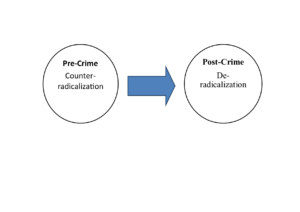
Recently, thousands of people who moved to Syria or Iraq to join Daesh have started returning home. According to Soufan Group, 5.600 foreign fighters have already returned to their origin countries and researches have started questioning some de-radicalization processes that have been adopted by some countries. In the article recent published by the Journal for Deradicalization, “De-radicalization and Counter-radicalization: Valuable Tools Combating Violent Extremism, or Harmful Methods of Subjugation?”, the researcher Tom Pettinger analyses some cases and discusses in which extent de-radicalization process is beneficial to the person or can contribute to stereotype and subjugate.
According to the study, the concept of de-radicalization is “the notion of psychological reform for those who have committed acts of terrorism.” Yemen was the first country to adopt the initiative when it is believe to have emerged, in 2001. The Yemeni Committee for Dialogue used this strategy as an attempt to re-educate the captured military after the Afghanistan invasion. The author makes a differentiation of terms: “de-radicalization [is] a post-crime process”, while “pre-crime individuals holding radical views could be called to counter-radicalization”:
Mr. Pettinger says de-radicalization programs can vary from informal chats with prisoners to intensive courses of weeks and years. There, prisoners learn more about Islam and are conducted to abandon radical beliefs. Proponents of the program say that de-radicalization can reduce the risk of individuals taking violence as legitimate, which can help governments to save money, once preventing is cheaper than fighting. The success of the program is measured through recidivism rates, which are generally very positive.
However, according to the author, these rates are not always real. They are distorted by results incorrectly informed by the countries and by the non-representativeness since the project participants are volunteers and represent only a part of all the militants. In addition, the projects are focused not explicitly on violent extremists, but in lower-level supporters. There is a silencing of complaints that could be discussed within society: the ability to debate and maintain different visions seems to be nullified.
The study also shows that 70% of people conducted to de-radicalization programs are Muslims and they are assisted by non-specialists who act intuitively. To Mr. Pettinger:
Overturning the oppressive term ‘de-radicalization’ is critical, as it helps to construct suspect communities, definable by their skin color or choice of clothing, and encourages a silencing of deviant and contrary perspectives which a democracy needs to be able to cope with
Besides being indicated to prisoners, some countries have already started adopting de-radicalization measures with young people and even children who show some kind of sympathy for extremist groups. The article presents the case of the nine-year-old British boy Haroon, who watched a video of Daesh and talked about it at school. Afterwards, his parents were advised to take him to a de-radicalization program for one year. The case of the child Haroon raised the question about to what extent it could represent a national threat. To Mr. Pettinger, de-radicalization programs can be one of the main ways to “help to disassociate the role of ideology in causing terrorism, which has been a significant cause of stigmatization for Muslims around the world”, but to have a positive impact, one should be sent to these programs based on some requirements (such as the evidence of risk) instead of intuition and prejudice.
The full report can be accessed here: http://journals.sfu.ca/jd/index.php/jd/article/view/109/91
By Larissa Infante (UFRJ)





